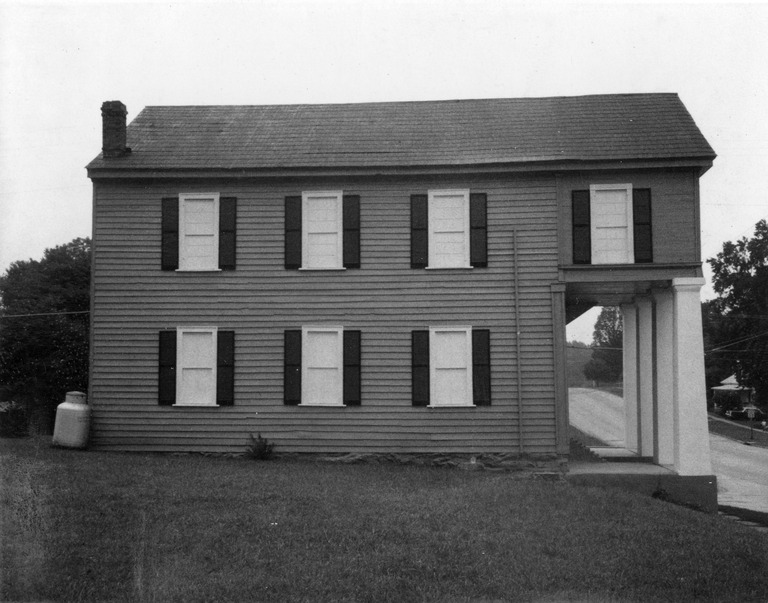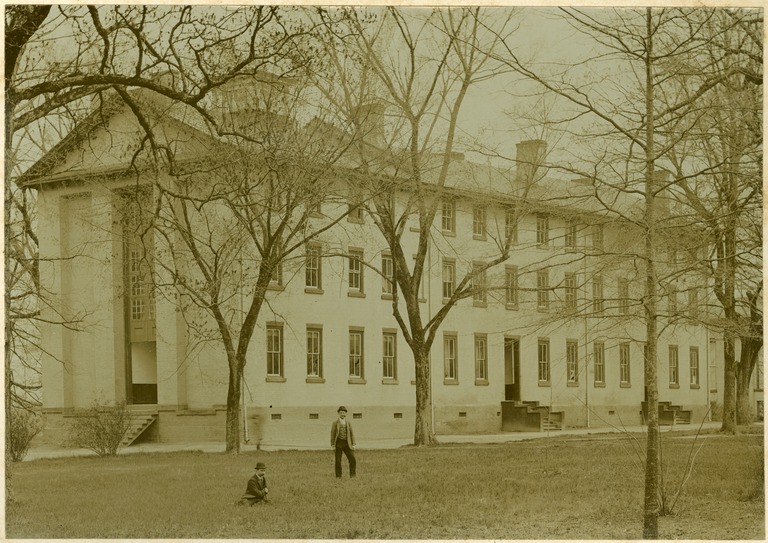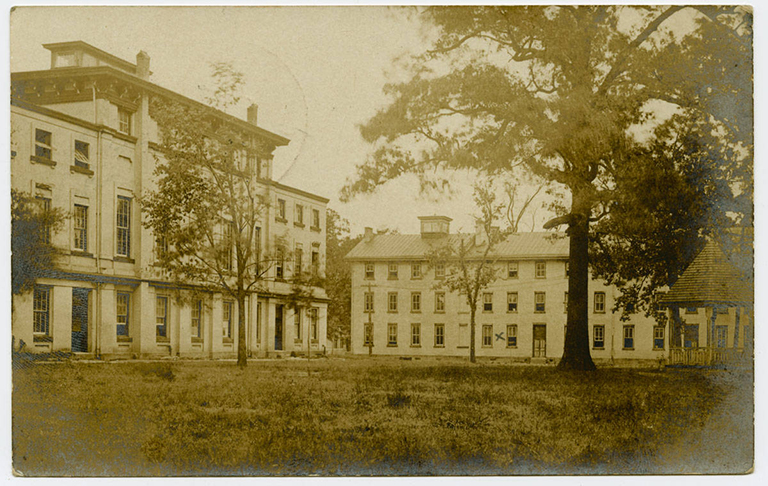Collier, Isaac J. (b. ca. 1810)
Variant Name(s):
Isaac Jones Collier
Birthplace:
North Carolina, USA
Residences:
- Chapel Hill, North Carolina
Trades:
- Carpenter/Joiner
- Contractor
NC Work Locations:
Building Types:
Styles & Forms:
Gothic Revival; Greek Revival; Italianate
Isaac J. Collier (b. ca. 1810) was a cabinetmaker, carpenter, and contractor who worked in Chatham and Orange Counties from the 1830s into the 1850s, often in partnership with other artisans. Like many small-town and rural woodworkers, he combined trades in furniture making and building. He was one of several antebellum local artisans who mustered the skills to execute the unfamiliar designs of nationally known architects in small town settings, most notably the additions designed by architect Alexander Jackson Davis for Old East and Old West at the University of North Carolina. When Davis’s friend and patron Robert Donaldson advised Davis to take into consideration the local materials and workmen in planning buildings for the university, men like Collier were those he had in mind.
In 1833, Isaac Collier opened a cabinet shop in Chapel Hill with Jones Watson, but this arrangement proved short-lived; by 1836, Collier formed a partnership in a cabinet shop with Kendall B. Waitt, a Chapel Hill artisan from Massachusetts, with whom he maintained a long association. Collier’s first known building project was the Columbus Lodge No. 102 in Pittsboro, the county seat of Chatham County. He and local builder Martin Hanks constructed the straightforward, 2-story frame building in 1838-1839; in 1849 a Greek Revival portico extension was added. Lodge minutes of April 3, 1839, state that “The Building Committee shall have full power to proceed to complete original contract with Bros. Hanks and Collier and failing therein make other contract or contracts as they deem best to finish work on the Lodge Hall.” (Both men were members of the lodge, and Collier was also its secretary.)
In Chapel Hill, Collier soon became involved in several important building projects, including brick edifices designed by nationally known architects. Since Collier was a woodworker by trade, evidently he had mastered the skills of managing a work force encompassing bricklayers and other artisans. In 1844 he served as contractor for the Chapel of the Cross, built from a design by Philadelphia architect Thomas U. Walter. On December 23, 1844, Collier and Kendall B. Waitt were awarded the large contract to erect the 3-story brick additions, designed by New York architect Alexander Jackson Davis, for Old East and Old West at the University of North Carolina. Collier and Waitt subcontracted the masonry work to Raleigh brick contractor Dabney Cosby and hired Raleigh carpenter F. L. Walthall and probably several black carpenters to accomplish much of the carpentry.
Right after the contract was awarded, Charles Manley, secretary of the university’s board of trustees, wrote to university president David L. Swain on December 24, 1844, regarding his slave workmen: “I wish you would make Collier and Waite hire my carpenters and boys—I have already written them on the subject by Prof. Phillips.” By March 1846 Collier and Waitt reported that the floors and roofs of the buildings were completed, and received a payment of $2,000. After encountering problems with architect Davis’s design of the cornice and brackets, Collier traveled to New York in June 1846 to consult with the architect.
Collier continued to serve a Chapel Hill clientele for smaller projects. Lucy Martin Battle reported regularly on local events, including building projects, in her letters to her husband, William Horn Battle. She wrote on October 4, 1845, that “Miss Mallet” intended to build, and on April 8, 1848, she stated that Kendall Waitt had offered to build the Phillips family a house for the same price that “Mr. Collier” had built Miss Sally Mallette’s house. (The Mallette-Wilson House, a modest frame dwelling, still stands in Chapel Hill.) Lucy Battle subsequently reported on September 24, 1851, that Collier was completing a house for Elizabeth Nunn, widow of a local innkeeper. Collier probably built others of the relatively modest, simply finished frame houses in town.
Collier was one of many artisans who combined his trade with farming. The U.S. census of 1850 listed him as a 40-year-old farmer in Orange County with property valued at $575. He headed a household of fourteen people, including his wife Eliza and their five children, plus five men in their twenties, listed as carpenters, who probably composed part of his work force: James Harris, H. G. Hatch, Owen Hamlet, Moses Hutchins, and William Williams. The last known references to Collier are from the mid-1850s: in 1853 he bought a lot at the northwest corner of Rosemary and Hillsborough Streets in Chapel Hill, where he built a 2-story frame house at 315 E. Rosemary Street, which he sold in 1856 for $1,850. Thereafter, Collier disappears from the record; neither he nor his family members can be found in the census of 1860.
- M. Ruth Little, The Town and Gown Architecture of Chapel Hill, North Carolina, 1795-1975 (2006).
- Charles Manly to David L. Swain, Dec. 24, 1844, David L. Swain Papers, North Carolina State Archives, Raleigh, North Carolina.
- Philip A. Rees, “The Chapel of the Cross, An Architectural History,” M.A. thesis, University of North Carolina at Chapel Hill (1979).
- University of North Carolina Board of Trustees Minutes, Dec. 23, 1844, 6, University Archives, University of North Carolina at Chapel Hill, Chapel Hill, North Carolina.
- University Papers, University Archives, 1844-1846, University of North Carolina at Chapel Hill, Chapel Hill, North Carolina.
- James Vickers, Chapel Hill: An Illustrated History (1985).
Chapel of the Cross
Contributors:Isaac J. Collier, contractor; Thomas U. Walter, architectDates:1842-1848
Location:Chapel Hill, Orange CountyStreet Address:304 E. Franklin St., Chapel Hill, NC
Status:Standing
Type:Religious
Images Published In:Catherine W. Bishir and Michael T. Southern, A Guide to the Historic Architecture of Piedmont North Carolina (2003).
Frances Benjamin Johnston and Thomas Tileston Waterman, The Early Architecture of North Carolina (1941).
M. Ruth Little, The Town and Gown Architecture of Chapel Hill, North Carolina, 1795-1975 (2006).Note:A water-colored elevation drawing signed “T. U. Walter, 1843” has been linked to the Chapel of the Cross. However, there are differences between the drawing and the church as built; it may be that Walter made the elevation from his original (missing) drawings for the church. How much the actual building deviated—perhaps for reasons of economy—from Walter’s original drawings is not known.
Collier-Mangum-Smith House
Contributors:Isaac J. Collier, builderVariant Name(s):Mangum-Smith House
Dates:Ca. 1853
Location:Chapel Hill, Orange CountyStreet Address:315 E. Rosemary St., Chapel Hill, NC
Status:Altered
Type:Residential
Images Published In:M. Ruth Little, The Town and Gown Architecture of Chapel Hill, North Carolina, 1795-1975 (2006).
Columbus Lodge No. 102
Contributors:Isaac J. Collier, builder; Martin Hanks, builderVariant Name(s):Pittsboro Masonic Lodge
Dates:1838-1839; 1849
Location:Pittsboro, Chatham CountyStreet Address:East St., Pittsboro, NC
Status:Standing
Type:Fraternal
Images Published In:Catherine W. Bishir and Michael T. Southern, A Guide to the Historic Architecture of Piedmont North Carolina (2003).
Mallette-Wilson House
Contributors:Isaac J. Collier, builderDates:Ca. 1845
Location:Chapel Hill, Orange CountyStreet Address:215 W. Cameron Ave., Chapel Hill, NC
Status:Standing
Type:Residential
Images Published In:M. Ruth Little, The Town and Gown Architecture of Chapel Hill, North Carolina, 1795-1975 (2006).
Note:Lucy Battle wrote in 1845 that Miss Mallet(te) intended to build a house, and in 1848 referred to a house that Collier had recently built for her. As noted by Ruth Little in Town and Gown Architecture, Sally Mallette, daughter of an early settler in Chapel Hill, ran a student boarding house here, and after her brother Edward was killed in the Civil War, she raised his five children here. The modest, 2-story frame house was later the home of Dr. Thomas J. Wilson.
Old East
Contributors:Albert and Osborne, plasterers (1844-1848); Atwood and Nash, architects and engineers (1924); Thomas C. Atwood, engineer (1924); Isaac J. Collier, contractor (1844-1848); Dabney Cosby, brick contractor (1844-1848); Alexander Jackson Davis, architect (1844-1848); Thomas Day, cabinetmaker (1844-1848); Arthur C. Nash, architect (1924); William Nichols, architect (1822); James Patterson, builder (1793-1795); Kendall B. Waitt, contractor (1844-1848)Dates:1793-1795; 1822 [addition]; 1844-1848 [addition]; 1924 [internally reconstructed]; 1991-1992 [extensive renovation]
Location:Chapel Hill, Orange CountyStreet Address:University of North Carolina, Chapel Hill, NC
Status:Standing
Type:Educational
Images Published In:John V. Allcott, The Campus at Chapel Hill: Two Hundred Years of Architecture (1986).
Catherine W. Bishir, North Carolina Architecture (1990).
Catherine W. Bishir and Michael T. Southern, A Guide to the Historic Architecture of Piedmont North Carolina (2003).
Edward T. Davis and John L. Sanders, A Romantic Architect in Antebellum North Carolina: The Works of Alexander Jackson Davis (2000).
M. Ruth Little, The Town and Gown Architecture of Chapel Hill, North Carolina, 1795-1975 (2006).
William S. Powell, The First State University: A Pictorial History of the University of North Carolina (1992).Note:Old East is the oldest building on UNC campus. It was enlarged and given the Tuscan end bay by Alexander Jackson Davis. See North Carolina Architecture and Architects and Builders in North Carolina for details and J. Marshall Bullock, “The Enterprising Contractor, Mr. Cosby,” for a detailed account of Dabney Cosby’s involvement in the Old East and Old West projects. As documented in extensive correspondence, Thomas Day planned and produced the interior woodwork, seating, etc. for the library and debating hall in Old East. Nothing is known to survive of his work there. The building was gutted and rebuilt within the old walls in 1924.
Old West
Contributors:Albert and Osborne, plasterers (1844-1848); Atwood and Nash, architects and engineers (1924); Thomas C. Atwood, engineer (1924); Isaac J. Collier, contractor (1844-1848); Dabney Cosby, brick contractor (1844-1848); Alexander Jackson Davis, architect (1844-1848); Thomas Day, cabinetmaker (1844-1848); Arthur C. Nash, architect (1924); William Nichols, architect (1822-1823); Kendall B. Waitt, contractor (1844-1848)Dates:1822-1823; 1844-1848 [addition]; 1924 [renovation]; 1991-1992 [extensive renovation]
Location:Chapel Hill, Orange CountyStreet Address:University of North Carolina, Chapel Hill, NC
Status:Standing
Type:Educational
Images Published In:John V. Allcott, The Campus at Chapel Hill: Two Hundred Years of Architecture (1986).
Catherine W. Bishir, North Carolina Architecture (1990).
Catherine W. Bishir and Michael T. Southern, A Guide to the Historic Architecture of Piedmont North Carolina (2003).
Edward T. Davis and John L. Sanders, A Romantic Architect in Antebellum North Carolina: The Works of Alexander Jackson Davis (2000).
M. Ruth Little, The Town and Gown Architecture of Chapel Hill, North Carolina, 1795-1975 (2006).
William S. Powell, The First State University: A Pictorial History of the University of North Carolina (1992).Note:Alexander Jackson Davis enlarged and remade the north façades of Old East and Old West with Tuscan end bays to face Franklin Street. Builder Dabney Cosby questioned his design. As documented in extensive correspondence, Thomas Day planned and produced the interior woodwork, seating, etc. for the library and debating hall in Old West. Nothing is known to survive of his work there. See J. Marshall Bullock, “The Enterprising Contractor, Mr. Cosby,” for a detailed account of Cosby’s involvement in the Old East and Old West projects. The photograph shows Old West on the right.




